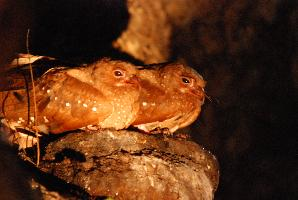
Súlyok és méretek
| Hossz | 41-tól 48-ig cm |
|---|---|
| Súly | 350-tól 475-ig g |
| Szárnyfesztávolság | 91 cm |
Állatleírás
The Oilbird, scientifically known as Steatornis caripensis, is a truly unique and fascinating avian species, not just because of its distinctive lifestyle and dietary habits, but also due to its exceptional navigational abilities. This nocturnal bird is native to the northern regions of South America, predominantly found in countries such as Venezuela, Trinidad, Colombia, and parts of the northern Andes. Its name, Oilbird, derives from the historical practice of harvesting the fat-rich chicks for oil production, a testament to its unique diet and biology.The Oilbird is a medium to large bird, measuring approximately 40 to 49 cm in length and weighing around 350 to 475 grams. It possesses a remarkable plumage that is primarily chestnut in color, with white spots scattered across its wings and tail. This plumage not only provides excellent camouflage within the dimly lit caves and forests it inhabits but also aids in its nocturnal lifestyle.
One of the most distinctive features of the Oilbird is its diet. Unlike any other bird, it feeds almost exclusively on the fruits of oil palm trees and other tropical plants, making it the world’s only known obligate frugivorous nocturnal bird. This diet is high in fat, which is essential for its energy-intensive flying style. The bird's digestive system is uniquely adapted to extract the maximum amount of fat from its food, a trait that led to its exploitation for oil production in the past.
Oilbirds are renowned for their exceptional navigational abilities. They are one of the few bird species that utilize echolocation to navigate through their dark cave habitats. Emitting a series of clicks, the Oilbird can navigate and locate food in complete darkness, a skill that is more commonly associated with bats than birds. This echolocation ability is facilitated by a highly developed auditory system, which allows the bird to interpret the echoes returning from its clicks to avoid obstacles and find its way.
The breeding habits of the Oilbird are as unique as its diet. Nesting exclusively in caves, the birds use the same communal roosting sites year after year, with some caves housing thousands of individuals. The female lays two to four eggs on a rudimentary nest made of regurgitated fruit pulp, which also serves as a nutrient-rich food source for the chicks. Both parents share the responsibility of feeding and raising the young, which are incredibly fat at birth due to the high-fat diet they receive.
Conservation of the Oilbird involves protecting its specialized habitat, particularly the cave systems it relies on for roosting and breeding. While not currently listed as endangered, the species is vulnerable to habitat destruction and disturbance of its roosting sites. Efforts to conserve the Oilbird and its habitat are crucial for maintaining the ecological balance of the regions it inhabits, as well as for preserving this remarkable species for future generations.
In conclusion, the Oilbird is a testament to the diversity and complexity of the natural world. Its unique dietary habits, exceptional navigational abilities, and specialized breeding strategies make it one of the most intriguing bird species on the planet. Protecting the Oilbird and its habitat is not just about conserving a single species; it's about preserving the intricate web of life that sustains our planet's biodiversity.
Új állatfotók
Top 10 állat
- Dolphin gull (Leucophaeus scoresbii)
- Japanese macaque (Macaca fuscata)
- Stone loach (Barbatula barbatula)
- Galápagos tortoise (Geochelone nigra complex)
- Russian tortoise (Testudo horsfieldii)
- Diana monkey (Cercopithecus diana)
- Greek tortoise (Testudo graeca)
- Common flying dragon (Draco volans)
- Moustached guenon (Cercopithecus cephus)
- Galápagos penguin (Spheniscus mendiculus)